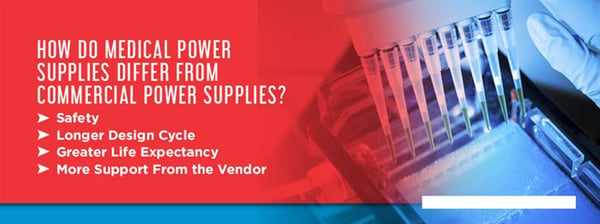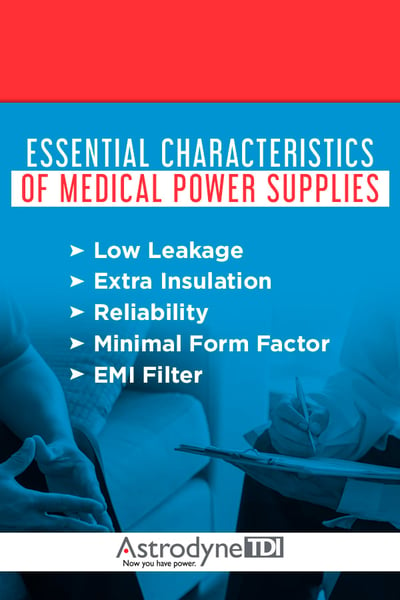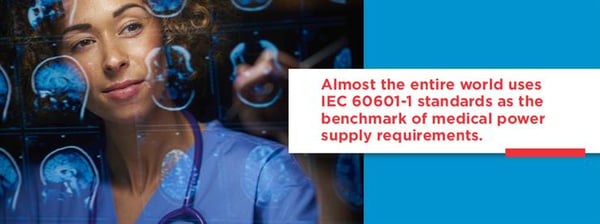RESOURCES
Choosing Medical Power Supplies
The world of medicine looks different than ever before, with more devices needing more power. MedTech Europe, a trade association that represents manufacturers in the industry, estimates that there are more than 500,000 products available in the medical technology industry. The majority of these products don't operate in a vacuum — they need the power to perform their intended functions.
Power supplies intended for medical applications may appear to be similar to their counterparts in commercial use, but the standards governing medical-grade power supplies are much more stringent. Let's take a look at how power supply for medical equipment is a cut above what you'll find in other industries.
How Medical Power Supplies Are Used
You can hardly walk into a room in a medical facility without encountering a piece of equipment that requires a power supply to function. Some of the devices won't come into contact with patients at all, and others require direct contact. Just a few of the more familiar devices include:
- X-ray
- Magnetic resonance imaging (MRI)
- Positron emission tomography (PET)
- Computed tomography (CT)
- Electroencephalography (EEG)
- Blood analyzers
- DNA sequencers
- Patient monitors
- Robotic surgical devices
- Ultrasounds
- Heart-lung machines
- Diagnostic equipment
A patient will likely never come into contact with the machine that analyzes their blood samples. But if they need an EEG, they are directly connected to the device and can suffer extremely adverse effects if the power supply were to malfunction.
Medical-grade power supplies are divided into three categories based on how much contact they make with the patient, and each type has specific standards for the power supply it requires. "Applied part" refers to the section of the device that makes physical contact with the patient during operation. These are the three classes of applied parts:
- Type B: Body devices such as hospital beds have the least stringent standards.
- Type CF: Cardiac floating devices that make direct contact with the heart, such as a dialysis machine, have the most stringent standards.
- Type BF: Body floating devices like blood pressure monitors fall in between type B and type CF parts.
Every medical facility will have a significant range of devices spanning all three types of applied parts, and patients will interact with at least one on every visit.

How Do Medical Power Supplies Differ from Commercial Power Supplies?
If you were to look at a 500 watt (W) enclosed switching power supply designed for medical use side-by-side with one manufactured for commercial applications, you might be able to see a meaningful difference right off the bat. They are ostensibly designed to do the same thing — deliver power to devices — so what sets apart the power supply for medical equipment? These four qualities make a difference.
1. Safety
Patients are of paramount concern with every medical device. For a device to be medical grade, it has to meet the International Electrotechnical Commission (IEC) 60601 standards. IEC 60601 standards require that medical power supplies meet rigorous safety standards in their design to ensure that patients have optimal protection. Commercial power supplies don't have to contend with these strict requirements.
2. Longer Design Cycle
With all the medical equipment safety standards that must be met, medical power supplies take longer to design and refine than their commercial counterparts. This is advantageous because it often means more potential issues are worked out during the design phase, and products don't need to be replaced as often as newer iterations appear.
3. Greater Life Expectancy
Along with a longer design cycle comes a greater life expectancy for products. Medical professionals expect to be able to use devices and their power supplies for years before they reach the end of their usable life. Medical power supplies can take up to five years to be certified, so it makes sense to create a design that lasts at least that long in practice. Commercial power supplies, on the other hand, cost less to develop and may only last a few years.
4. More Support from the Vendor
Power supplies that have a longer life expectancy require more vendor support. When something goes wrong with a medical power supply or a medical professional has questions, there's no room for wasting time trying to get a hold of the vendor. Medical-grade power supplies come with much more responsive and reliable vendor support than your average commercial devices.

Essential Characteristics of Medical Grade Power Supplies
There are many medical power supply considerations to take when choosing new products. These five characteristics are must-haves for any quality power supply.
1. Low Leakage
People in medical settings — especially hospitals — are often quite weak. If there are any leakages in current, it can adversely affect their health. While the same amount of leakage would likely not cause any harm to a healthy person using a device in industrial settings, it can cause real damage in medical applications, making low leakage power supplies essential. IEC 60601 standards establish medical power supply leakage requirements to ensure patients are protected from currents that might harm their health.
2. Extra Insulation
Most commercial power supplies aren't part of devices that interface directly with the human body. As such, their design is less concerned with safety in this regard. Medical-grade power supplies feature extra insulation at more points, to keep both patients and device operators shielded from electrical shock.
3. Reliability
The stakes are much higher for medical-grade equipment. If a power supply malfunctions during a robotically-assisted surgery, life may be lost. Medical equipment must be of the utmost reliability to be a good investment. Manufacturing facilities for medical-grade power supplies should be International Organization for Standardization (ISO) certified to ensure each product is built to be as reliable as possible.
4. Minimal Form Factor
As technology continues to advance, devices are getting smaller and smaller. Medical power supplies are no different. To be most versatile, these devices need to be relatively small as well as portable. There is sometimes a trade-off between size and power that makes smaller power supplies with greater output more expensive, but the best products on the market do not sacrifice on size, power or price.
5. EMI Filter
Many of the typical devices using power supplies, like patient monitoring devices, use low-level signals to operate. This makes the equipment more susceptible to electromagnetic interference (EMI). Electromagnetic compatibility (EMC) is one element of IEC 60601 standards. It's worth noting that power supplies with EMI filters have capacitors that permit a certain amount of leakage current, and the more effective the EMI filter, the more leakage it produces.

Medical Power Supply Standards
Almost the entire world uses IEC 60601-1 standards as the benchmark of medical power supply requirements. The standards are reevaluated and revamped every few years, and not every country follows the same edition at the same time. For example, New Zealand and Japan were still following IEC 60601-1 second edition requirements after the U.S., Canada, and the European Union had already accepted IEC 60601-1 third edition requirements.
The fourth edition of IEC 60601-1 standards is the most current. As always, the new edition builds on previous editions rather than acting as a wholesale replacement. The fourth edition contains new guidance about risk management and other particulars like voltage dips, but the core standards remain intact.
1. Means of Protection (MOP)
All medical power supplies have to contain one or more means of protection (MOP) to keep the risk of electric shock to a minimum. The electrical safety of medical equipment relies on these MOPs. Of all the medical device safety standards, MOP may be the most crucial.
One of the changes implemented in the IEC 60601-1 third edition was to distinguish between means of patient protection (MOPP) and means of operator protection (MOOP). MOPs include air clearances, creepage distances, protective impedance, and insulation as part of the power supply requirements for medical applications. IEC standards for MOPs are as follows:
| Classification | Isolation | Creepage | Insulation |
| 1xMOOP | 1500V AC | 2.5mm | Basic |
| 2xMOOP | 3000V AC | 5mm | Double |
| 1xMOOP | 1500V AC | 4mm | Basic |
| 2xMOPP | 4000V AC | 8mm | Double |
2. Leakage Standards
Leakage current is also known as touch current, and IEC 60601-1 is very specific on how much a medical device can produce. The medical power supply characteristics for leakage standards are broken up by applied part type. A leakage test for a medical device must show touch current levels below the following maximums:
Type B Devices: No Patient Contact
| Leakage | Normal Operation | Single-Fault |
| Earth | 500µA | 1mA |
| Case | 100µA | 500µA |
| Patient | 100µA | 500µA |
Type BF Devices: Patient Contact
| Leakage | Normal Operation | Single-Fault |
| Earth | 500µA | 1mA |
| Case | 100µA | 500µA |
| Patient | 100µA | 500µA |
Type CF Devices: Close or Direct Connection to the Heart
| Leakage | Normal Operation | Single-Fault |
| Earth | 500µA | 1mA |
| Case | 100µA | 500µA |
| Patient | 10µA | 50µA |
3. EMC Standards for Medical Device
As medical devices are almost always operating in relatively close proximity, their electromagnetic energy must not affect other devices nearby. Electromagnetic compatibility has two components — the device must not put out too much electromagnetic energy, and it should have a high degree of immunity to the electromagnetic energy around it.
The IEC 60601-1 section on EMC testing and requirements is extremely extensive, as it governs a huge range of devices with different applications. The fourth edition changed standards from the third edition in several ways, with these having the most impact:
- The range of radiated immunity testing increased from 2.5 GHz to 2.7 GHz.
- The magnetic immunity threshold increased to 30A/m.
- Conducted immunity at 6V in industrial, scientific and medical (ISM) radio bands.
- Additional phase angles for voltage interruptions and dips.
- Electrostatic discharge (ESD) increased from 6kV to 8kV for contact and 8kV to 15kV for air.
- Immunity to radiofrequency (RF) wireless communications fields must be tested at a minimum distance of 30 cm.
4. Risk Management for Medical Power Supplies
The standards for risk management have been bulked up in IEC 60601 fourth edition. Manufacturers will now have to prepare and submit a testing plan alongside a risk analysis document before products can undergo testing. The risk management process now takes into account reasonably foreseeable electromagnetic disturbances as well as minimum separation distance.
If a manufacturer reduces test level based on factors like the product's intended use, the reasons must be justified within the risk management documentation. These new requirements may contribute to a longer design cycle, but they also enhance the safety of the final product.
Tips for Selecting Medical Power Supplies
The needs of modern medical devices are many. Their power supplies need to be compact and portable as well as energy-efficient. Above all, they must be reliable and safe. The best way to get all of these qualities in your medical power supplies is to find an original equipment manufacturer (OEM) that has demonstrable experience in the field of medical electronics.
The medical electronics field is unique in that its stringent demands are subject to frequently-changing standards. Non-specialized OEMs simply can't keep up with the fast pace of development seen in this industry.
Medical grade power supplies are not something you can shop for based on price. While budgets must be considered, the need to avoid lawsuits and product recalls should steer you away from bargain-basement equipment. When safety is paramount, you need a reputable supplier that can provide quality products.
A good supplier can point you toward medical power supplies that are certified to meet medical power supply standards of the current IEC edition as well as European Standard (EN), Underwriters Laboratories (UL) and Canadian Standards Association (CSA) standards while meeting your budget.
When choosing specific power supplies, keep these considerations in mind:
- Design flexibility: It's always best to be prepared for unexpected design iterations. For example, rather than looking for a DC-DC converter with a 2:1 input range, consider a more versatile product with a 4:1 range.
- Standby power: The more devices you need to power, the more you need to worry about how much energy they consume in standby mode. Check standby specifications as a means of product comparison.
- Product warranties: You may be happy with a standard three-year medical power supply warranty, or you may wish to look for one that offers a five-year warranty. Ensure you understand warranty terms before making a selection.

Power Supply Advantages with Astrodyne TDI
There is no substitute for experience within the medical power supply marketplace. Astrodyne TDI has built up more than 50 years' worth of expertise in power supply for medical applications and EMI filter design, and it shows in our service and selection.
Astrodyne TDI has advanced engineering centers in both the U.S. and China, led by industry veterans and state-of-the-art technologies. Whether our customers need power supplies for life-saving heart assist devices or satellite communications systems, we have the solution. Our manufacturing facilities are certified ISO 9001 and ISO 13485 compliant to uphold the highest standards of quality consistently.
You'll find a comprehensive catalog of power supplies at your fingertips at Astrodyne TDI. If you can't find the perfect power supply solution, we invite you to contact us for a custom quote. Our engineers can use our modular and flexible designs as a base to create competitive products with the performance you need. With Astrodyne TDI, now you have power.

